warning PONTIAC GRAND-PRIX 1993 Owners Manual
[x] Cancel search | Manufacturer: PONTIAC, Model Year: 1993, Model line: GRAND-PRIX, Model: PONTIAC GRAND-PRIX 1993Pages: 338, PDF Size: 17.3 MB
Page 5 of 338
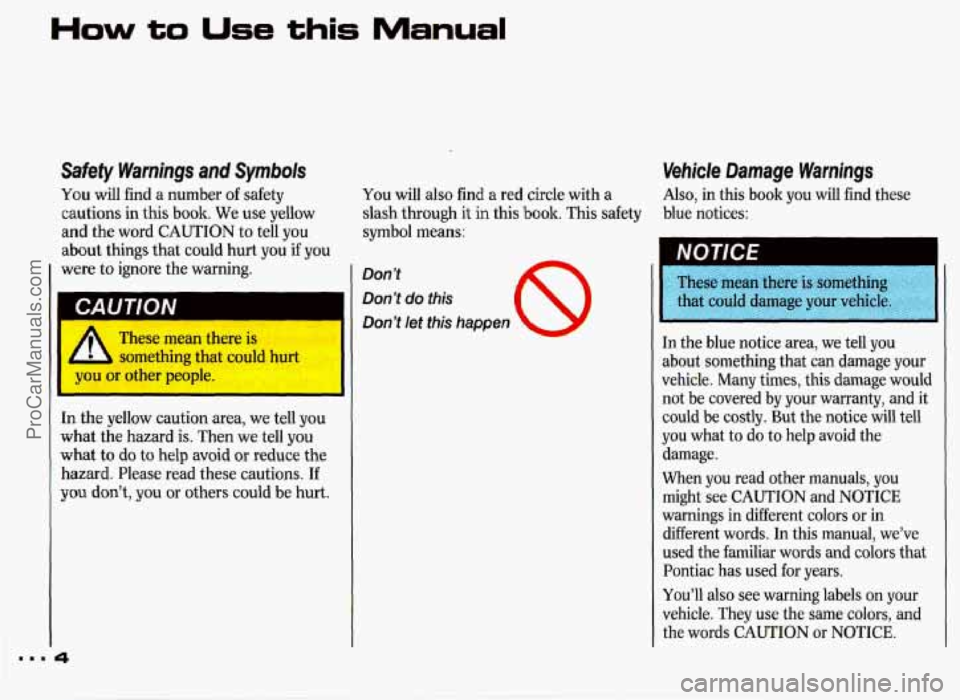
How to Use this Manual
Safety Warnings and Syrnbok
You will find a number of safety
cautions in this
book. We use yellow
Vehicle Damage Warnings
You will also find a red circle with a Also, in this book you will find these
slash through
it in this book. This safety blue notices:
and the word CAUTION to tell you symbol means:
about things that could hurt
vou if vou
were to ig&ore the warning. ” Don’t
Don’t
do this
Don’t let this happen
Y
bAU I IUIY I
, These mean there is
b something that could hurt
rou or other people. I
I 1 NOTICE
In the yellow caution area, we tell you
what the hazard
is. Then we tell you
what to
do to help avoid or reduce the
hazard. Please read these cautions. If
you don’t, you or others could be hurt.
..I 4
-7
In the blue notice area, we tell you
about something that can damage your
vehicle. Many times, this damage would
not be covered
by your warranty, and it
could
be costly. But the notice will tell
you what to do to help avoid the
damage.
When
you read other manuals, you
might see CAUTION and NOTICE
warnings in different colors or in
different words. In this manual, we’ve
used the familiar words and colors that
Pontiac has used for years.
You’ll also see warning labels on your
vehicle. They use the same colors, and
the words CAUTION or NOTICE.
ProCarManuals.com
Page 6 of 338
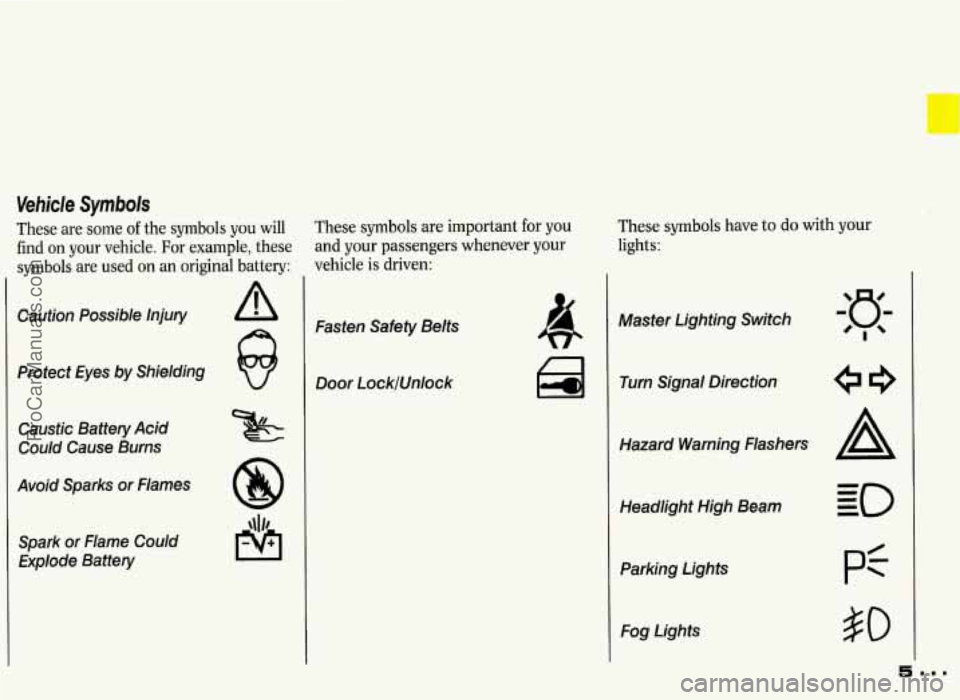
c
Vehicle Symbols
These are some of the symbols you will
find on your vehicle. For example, these
symbols are used
on an original battery:
I
Caution Possible Injury
Protect Eyes by Shielding
Caustic Battery Acid
Could Cause Burns
Avoid Sparks
or Flames
Spark or Flame Could
Explode Battery
These symbols are important for you
and your passengers whenever your
vehicle is driven:
Fasten Safety Belts
Door LocklUnlock
These symbols have to do with your
lights:
a Turn Signal Direction
Hazard Warning Flashers
Headlight High Beam
Parking Lights Fog Lights
ProCarManuals.com
Page 7 of 338
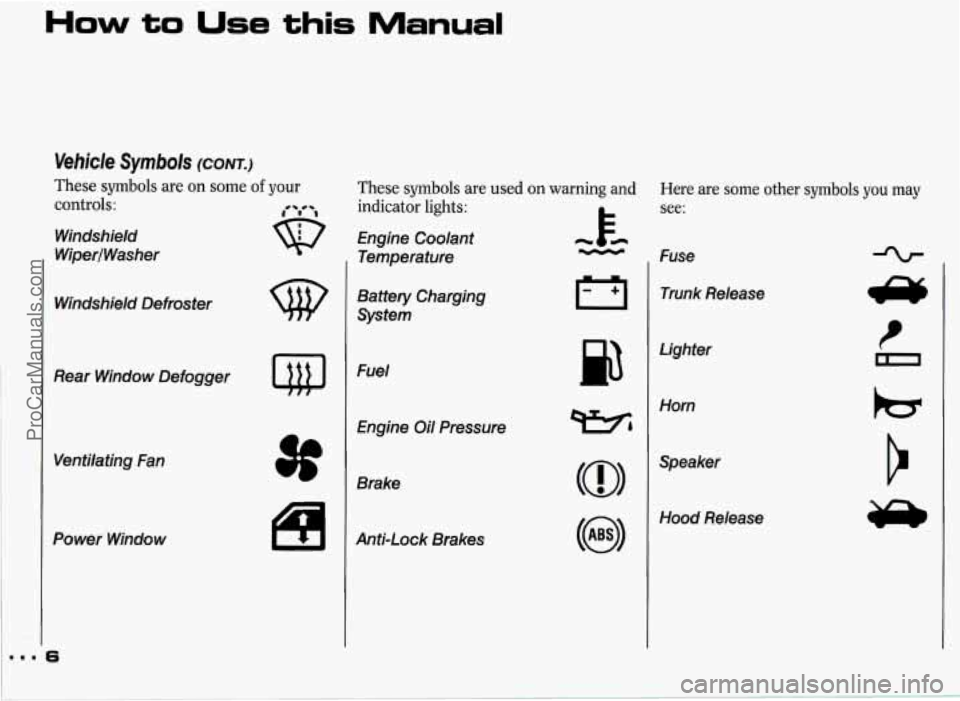
How to Use this Manual
Vehicle Symbols (CQNT.)
These symbols are on some of your
controls:
Windshield
WiperlWasher
Windshield Defroster
Rear Window Defogger
Ventilating Fan
Power Window
These symbols are used on warning and
indicator lights:
Engine Coolant - Fd
Temperature .HccF
Battery Charging
System
Fuel
Engine Oil Pressure
Brake
Anti-Lock Brakes
Here are some other symbols you may
see:
Fuse
Trunk Release
Lighter
Horn
Speaker
Hood Release
ProCarManuals.com
Page 20 of 338
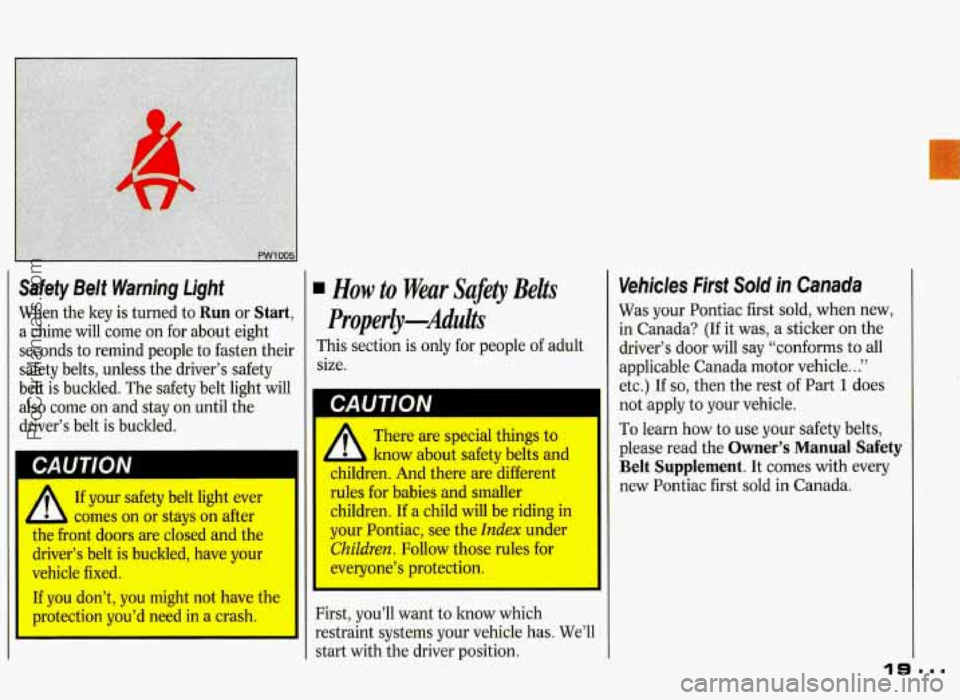
Safefy Belt Warning Light
When the key is turned to Run or Start,
a chime will come on for about eight
seconds to remind people
to fasten their
safety belts,
unless the driver‘s safety
belt
is buckled. The safety belt light will
also come on and stay on until the
driver’s belt is buckled.
CAUTION
If your safety belt light ever
tllc iont doors are closed and the
driver’s belt is buckled, have your
vehicle fixed.
If you don’t, you might not have the
protection you’d need in a crash.
h comes on or stays on after
This s6ction is only for people of adult
size.
I CAUTION
* There are special things to
2 know about safety belts and
children. And there are different
rules for babies and smaller
children.
If a child will be riding in
your Pontiac, see the
Index under
ChiZdren. Follow those rules for
everyone’s protection.
First, you’ll want
to how which
restraint
systems your vehicle has. We’ll
I start with the driver position.
Vehicles; Firsf SoEd in Canada
Was your Pontiac first sold, when new,
in Canada? (If it was, a sticker on the
driver’s door will say “conforms to all
applicable Canada motor vehicle.. .”
etc.) If so, then the rest of Part 1 does
not apply ta your vehicle.
To learn how to use your safety belts,
please read the Owner’s Manual Safety
Belt Supplement. It comes with every
new Pontiac first sold in Canada.
ProCarManuals.com
Page 44 of 338
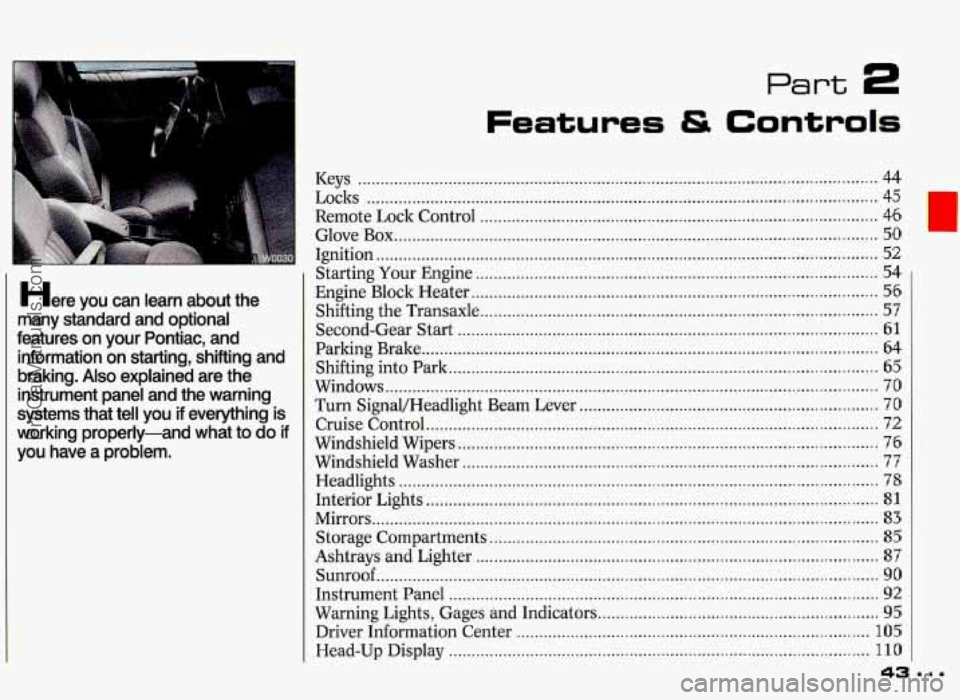
Here you can learn about the
many standard and optional
features on your Pontiac. and information on starting. shifting and
braking
. Also explained are the
instrument panel and the warning
systems that tetl you if everything is
working properly-and what to
do if
you have a problem .
Features & Controls
Keys ........................................................................\
........................................... 44
Locks ........................................................................\
......................................... 45
Remote Lock Control ........................................................................\
................ 46
Glove Box ........................................................................\
................................... 50
Ignition ........................................................................\
....................................... 52
Starting Your Engine ........................................................................\
................. 54
Engine Block Heater ........................................................................\
.................. 56
Shifting the Transaxle ........................................................................\
................ 57
Second-Gear Start ........................................................................\
..................... 61
Parking Brake ........................................................................\
............................. 64
Shifting into Park ........................................................................\
....................... 65
Windows ........................................................................\
..................................... 70
Turn Signal/Headlight Beam Lever .................................................................. 70
Cruise Control ........................................................................\
............................ 72
Windshield Wipers ........................................................................\
..................... 76
Windshield Washer ........................................................................\
.................... 77
Headlights ........................................................................\
.................................. 78
Interior Lights ........................................................................\
............................ 81
Mirrors ........................................................................\
........................................ 83
Storage Compartments ........................................................................\
.............. 85
Ashtrays and Lighter ........................................................................\
................. 87
Sunroof ........................................................................\
....................................... 90
Instrument Panel ........................................................................\
....................... 92
Warning Lights, Gages and Indicators .............................................................. 95
Driver Information Center ........................................................................\
...... 105
Head-Up Display ........................................................................\
..................... 110
ProCarManuals.com
Page 53 of 338
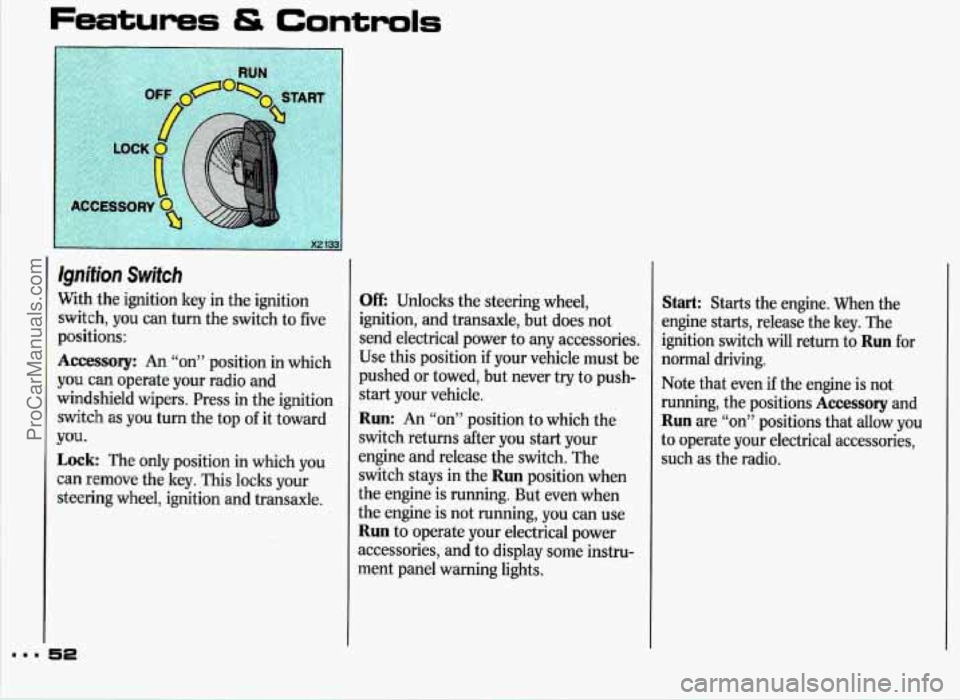
Features & Controls
Qnifion Switch
Nith the ignition key in the ignition
;witch, you can turn the switch to five
~ositions:
kccessory: An “on” position in which
rou can operate your radio and
vindshield wipers. Press in the ignition
;witch as you turn the top of it toward
Lock: The only position in which you
:an remove the key. This locks your
;teering wheel, ignition and transaxle.
TOU.
Off: Unlocks the steering wheel,
ignition, and transaxle, but does not
send electrical power to any accessories,
Use this position if your vehicle must
be
pushed or towed, but never try to push-
start your vehicle.
Run: An “on” position to which the
switch returns after you start your
engine and release the switch. The
switch stays in the
Run position when
the engine is running. But even when
the engine is not running, you can use
Run to operate your electrical power
accessories, and to display some instru-
ment panel warning lights.
Start: Starts the engine. When the
engine starts, release the key. The
ignition switch will return to
Run for
normal driving.
Note that even
if the engine is not
running, the positions
Accessory and
Run are “on” positions that allow you
to operate your electrical accessories,
such
as the radio.
ProCarManuals.com
Page 65 of 338
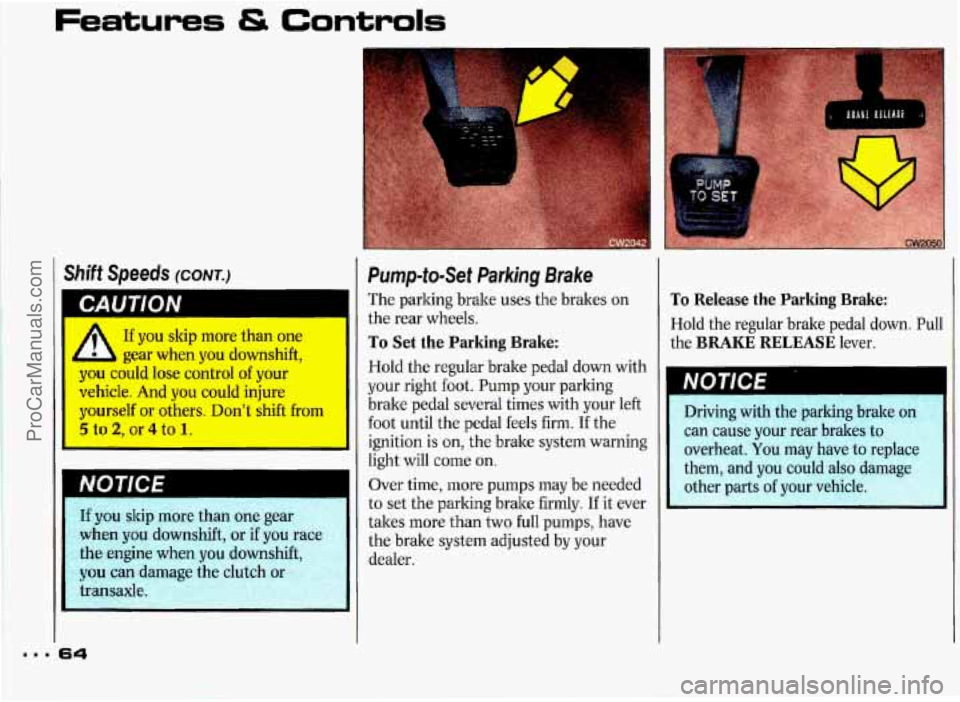
Features & Controls
I CAUTION
A If you skip more than one
L A gear when you downshift,
you could lose control of your
vehicle. And you could injure
yourself or others. Don’t shift from
5 tn 2 nr 4 tn 7.
If you skip nwrt: ~11arl one gear
when you downshift,
or if you race
the engine when you downshift,
you can damage the clutch nr
transaxle.
1
Pump-to-Set Parking Brake
The parking brake uses the brakes on
the rear wheels.
To Set the Parking Brake:
Hold the regular brake pedal down with
your right foot. Pump your parking
brake pedal several times with your left
foot until the pedal feels firm.
If the
ignition is
on, the brake system warning
light will come on.
Over time, more
pumps may be needed
to set the parking brake firmly. If it ever
takes more than two full pumps, have
the brake system adjusted by your
dealer.
To Release the Parking Brake:
Hold the regular brake pedal down. Pull
the
BRAKE RELEASE lever.
Driving with the parKing DraKe
on
can cause your rear brakes to
overheat. You may have to replace
them, and you could also damage
other parts of your vehicle.
ProCarManuals.com
Page 72 of 338
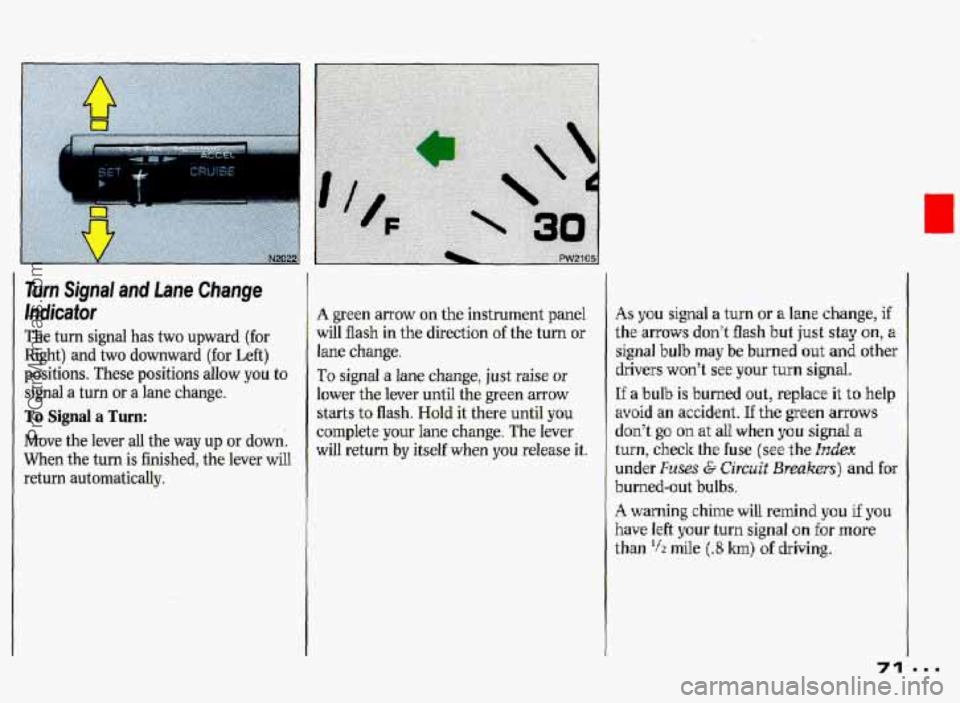
Turn Signal and Lane Change,
IndiGator
The turn signal has two upward (for
Right) and two downward (for Left)
po&iom. These positions allow you to
signal a turn or a lane change.
To Signal a Turn:
M.ove the lever all the way up or down.
When the turn is finished, the lever will
return automatically.
A green arrow on the instrument panel
will flash in the direction of the turn or
lane change.
To signal a lane change, just raise or
lower the lever until the green arrow
starts to flash. Hold it there until you
complete your lane change. The lever
will return by itself when you release it.
As you signal a turn or a lane change, if
the maws dcdt flash but just shy on, a
signal buJb may be burned out and other
drivers won’t see your tun signal.
If a bulb is burned out, replace it to help
amid an accident. If the green arrows
don’t pp on at all when you signal a
turn, check the fuse (see the
under Fuses E. Circait Blreakeus) and for
burned-out bulbs.
A warning chime will repnind you if you
have left your turn signal on faor more
than ‘1’2 mile (-8 km) of driving.
71
ProCarManuals.com
Page 79 of 338
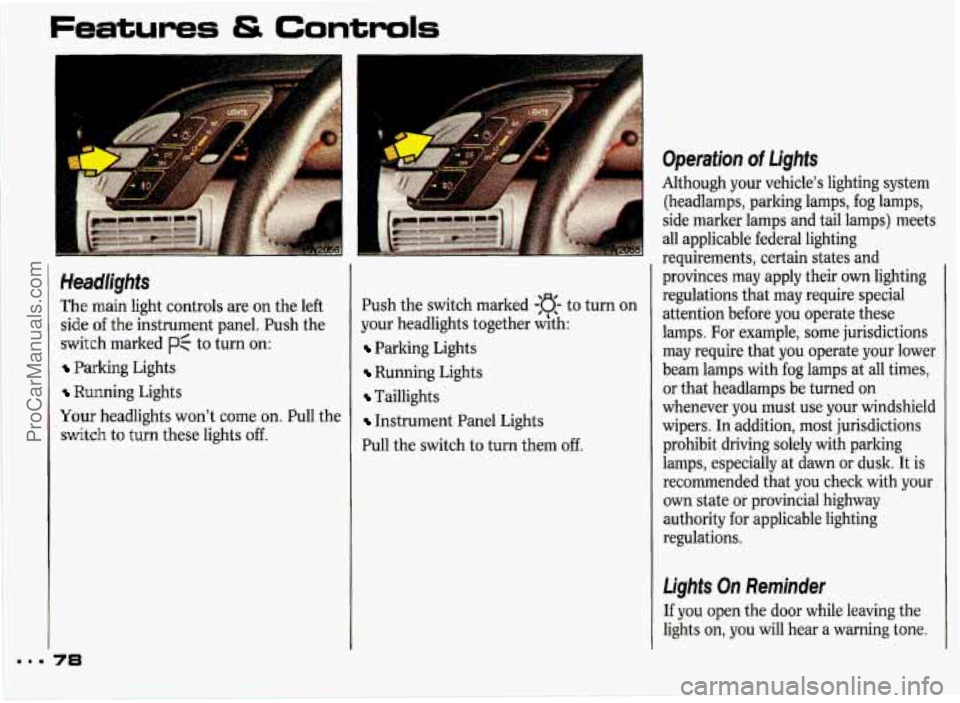
Features & Controls
“I
Headlights
The main light controls are on the left
side of the instrument panel. Push the
switch marked pf to turn on:
Parking Lights
Running Lights
Your headlights won’t come on. Pull the
switch to turn these lights off.
a
Push the switch marked -:a- to turn on
your headlights together with:
Parking Lights
Running Lights
Taillights
Instrument Panel Lights
Pull the switch to turn them off.
Operation of Lights
Although your vehicle’s lighting system
(headlamps, parking lamps, fog lamps,
side marker lamps and tail lamps) meets
all applicable federal lighting
requirements, certain states and
provinces may apply their own lighting
regulations that may require special
attention before you operate these
lamps. For example, some jurisdictions
may require that you operate your lower
beam lamps with fog lamps at all times,
or that headlamps be turned on
whenever you must use your windshield
wipers. In addition, most jurisdictions prohibit driving solely with parking
lamps, especially at dawn or dusk. It is
recommended that you check with your
own state or provincial highway
authority for applicable lighting
regulations.
Lights On Reminder
If you open the door while leaving the
lights on, you will hear a warning tone.
ProCarManuals.com
Page 94 of 338
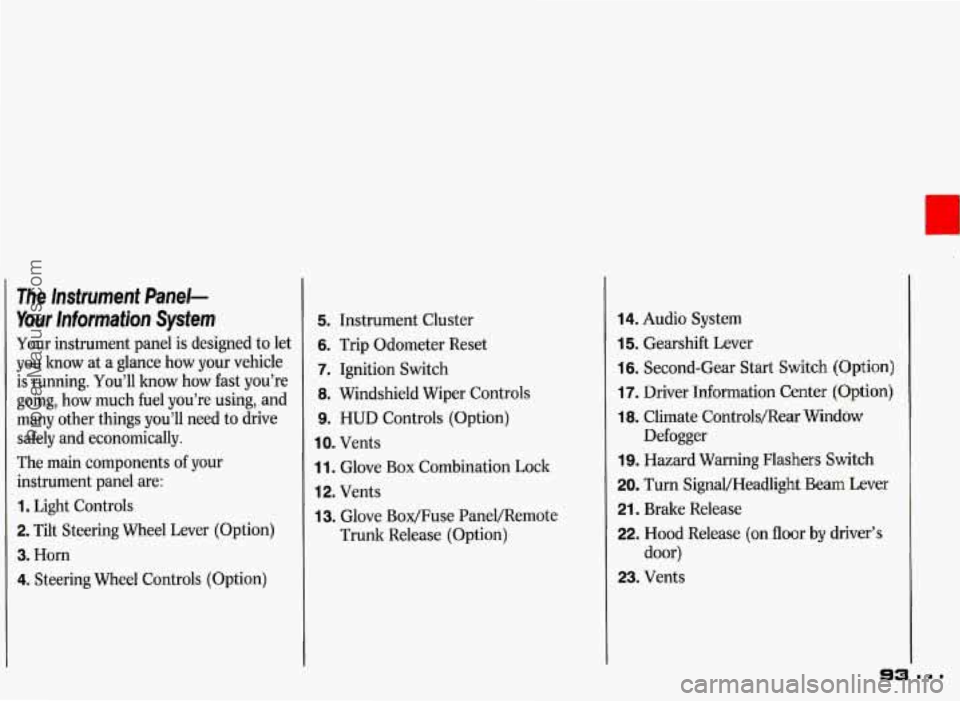
The Instrument Panel-
Your Information System
Your instrument panel is designed to let
you know at
a glance how your vehicle
is running. You’ll how how fast you’re
going, how much fuel you’re using, and
many other things you’ll need to drive
safely and economically.
The main components of your
instrument panel are:
1. Light Controls
2. Tilt Steering Wheel Lever (Option)
3. Horn
4. Steering Wheel Controls (Option)
5. Instrument Cluster
6. Trip Odometer Reset
7. Ignition Switch
8. Windshield Wiper Controls
9. HUD Controls (Option)
IO. Vents
1 1. Glove Box Combination Lock
12. Vents
13. Glove Box/Fuse PaneVRemote
Trunk Release (Option)
14. Audio System
15. Gearshift Lever
16. Second-Gear Start Switch (Option)
17. Driver Information Center (Option)
18. Climate Controls/Rear Window
19. Hazard Warning Flashers Switch
20. Turn SignaVHeadlight Beam Lever
21. Brake Release
22. Hood Release (on floor by driver’s
door)
23. Vents Defogger
ProCarManuals.com